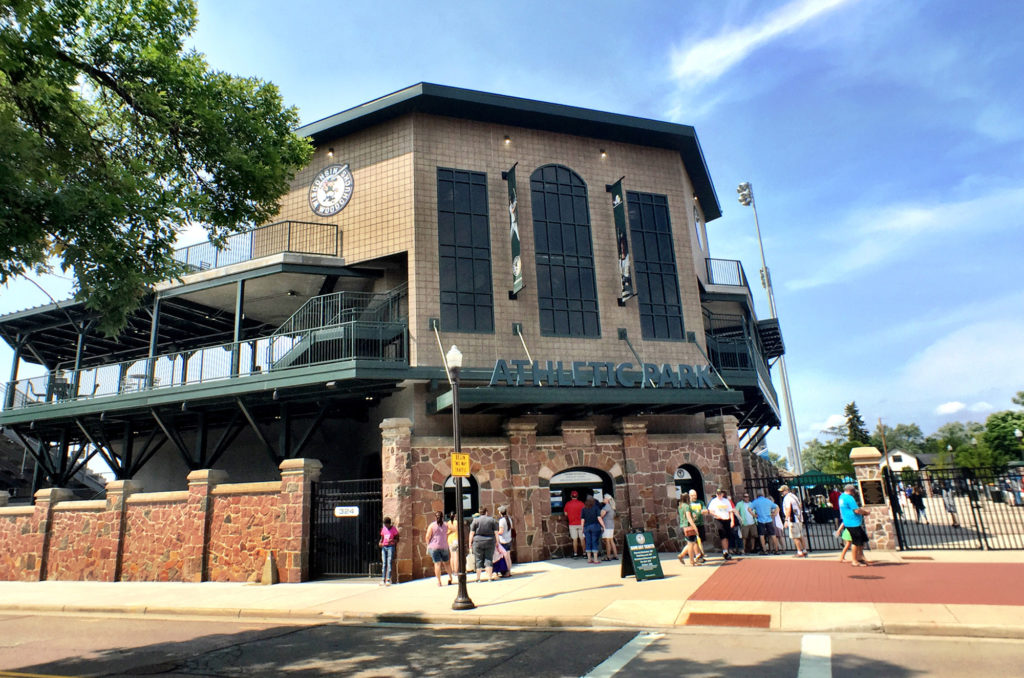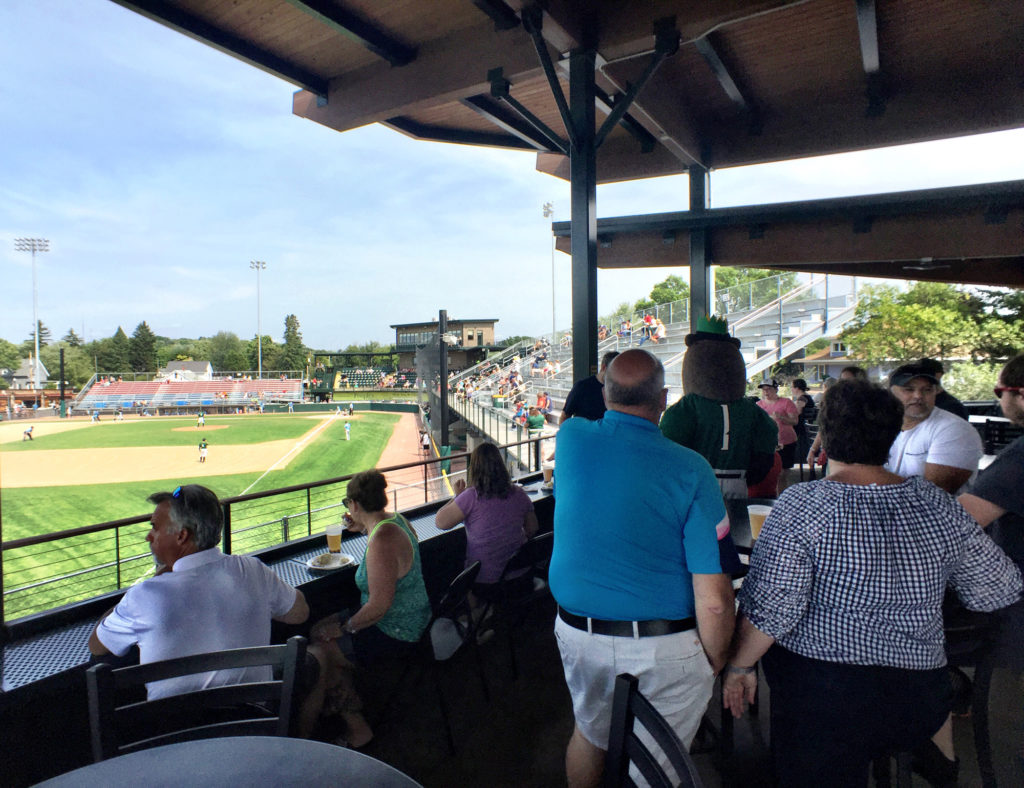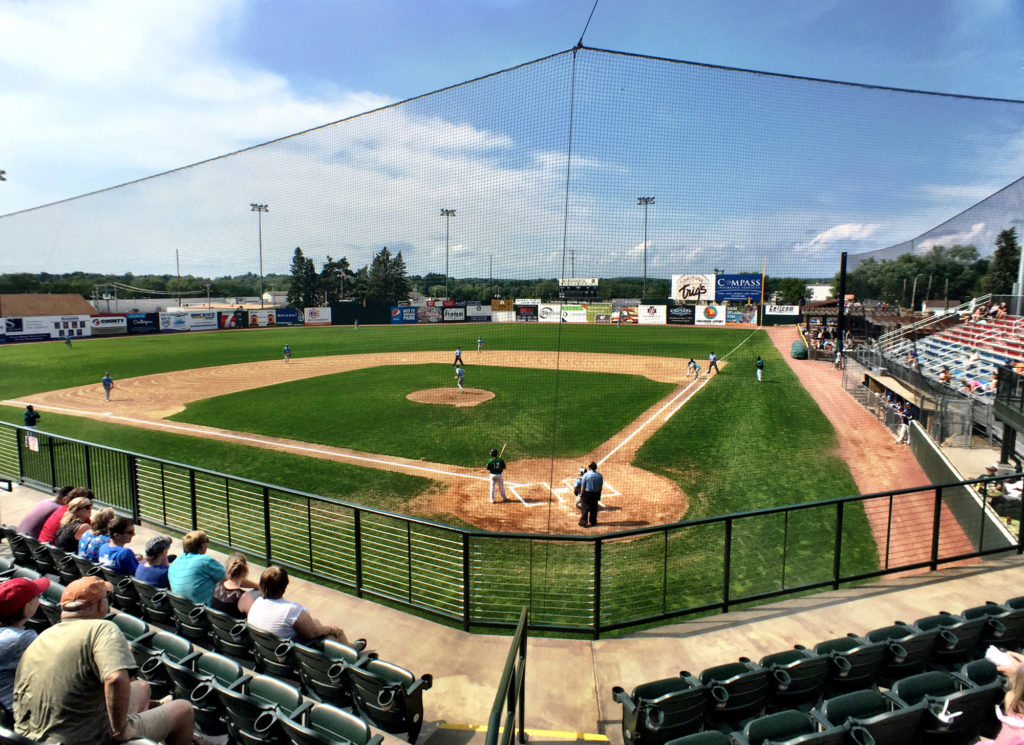One of the joys of working in the baseball world is being pleasantly surprised by ballpark changes happening over long periods of time—something made clear with a visit Sunday to Athletic Park, home of the Wisconsin Woodchucks (summer collegiate; Northwoods League).
This was our third visit to Athletic Park: the first came in 2002 with much of the original grandstand still in place, the second came after renovations spearheaded by the city and the prior Northwoods League ownership (the Woodchucks are a charter member of the Northwoods League, dating back to 1994), and the third Sunday. Each iteration revealed huge changes to the venerable old ballpark—changes that also reflected then-current operating procedures in Minor League Baseball and summer-collegiate baseball.
In a way, Athletic Park has always been in a constant state of redevelopment. The current ballpark owes much to a WPA-funded renovation in 1936, which provided a quaint old grandstand that was rebuilt, and a few years later the signature stone wall surrounding the ballpark. You can get a feel for that 1936 grandstand at the ticket stand on Wausau Avenue, and the stone wall is a constant presence as you navigate the ballpark.
Before that there was a small wooden grandstand at the current grandstand site, as baseball has been played at the current Athletic Park location since before the turn of the century. The ballpark configuration has the first-base line running north-south and the third-base line running east-west, providing for some views directly into the sun from the first-base bleachers at sunset. It’s not an uncommon problem in older ballparks predating nighttime lighting, like Pittsfield’s Wahconah Park.
“People ask me why we have a ballpark where you can be looking directly into the sun,” says team owner Mark Macdonald, a Wisconsin native who spent 30 years in the investment business before buying the Woodchucks. “When this ballpark was laid out, there was no such thing as a night game, so no one cared about sunsets.”
A three-year, $7-million renovation touched on every part of the ballpark. The grandstand added a third floor to the mix. A team store, ticket office and eight four-top tables occupy the first level, while a second level features 288 theater-style seats (complete with cupholders), bar-rail seating, press box, concessions stands and restrooms. The third level features three configurable suites (during our visit, the wall between two smaller suites was opened to accommodate a large church group) leading to outdoor seating.
New left-field bleachers were raised to both provide a better view of the ballpark as well as construction of new restrooms, a larger home dugout and storage facilities underneath, along with additional field-level half-moon tables. “We installed a new cold storage space here and we’re already outgrowing it,” Macdonald said.
In the left-field corner: a gorgeous new structure featuring a large concession stand on field level (provided a great standing-room view of the playing field), and second-floor group deck, seating 150, complete with its own concession stand. It’s built at an angle and butts up directly to the baseline.
Similar additions were made down the right-field line as well. A new Leinenkugel-sponsored area down the first-base line is geared toward groups of all sizes. For $28, you get all you care to eat, as well as vouchers for three. All in all, the upgrades allowed for more and better seating options while also allowing for better movement throughout the ballpark.
And the changes, when taken in totality, allowed the Woodchucks to sell to a different level of clientele. In the past you’d find a business making a yearly sojourn to the ballpark for a group activity, but the different levels of seating—the large group area, the climate-controlled suites, the field-level four tops—allow for a much different clientele to be approached by the Woodchucks sales staff. And it does so without sacrificing the game-day experiences for long-time fans and families.
“These additions really make it easier for a business to entertain at the ballpark—they can have private discussions and a great ballpark experience,” Macdonald said.
If you had visited Athletic Park before the current renovations, you probably were amazed by how land-locked the ballpark was, with commercial development past left field and residences surrounding the rest, Athletic Park had a tight fit. But Macdonald had a creative solution: North Fifth Street, located to the east of the ballpark, was closed off, and residences across the street from the ballpark were purchased and torn down, yielding much-needed space for a party tent, additional concessions and a large kids’ play area.
“The neighbors were pretty happy when we bought a house that was used as a meth house,” Macdonald said of the $33,000 purchase. “This gave us plenty of room to expand.”
The Wausau Lumberjacks played in the original Northern League during three different periods: 1909-1911, 1936-1942 and 1956-1957. Athletic Park was the home of the Lumberjacks from 1936 on. The late John Henry Moss did a stint running a Tigers farm team in Wausau. The Wausau Mets were in the Class A Midwest League from 1975-1978; the team was named the Wausau Timbers from 1979 to 1990, when the team moved to Geneva, Ill.
There likely will be more changes to Athletic Park in coming years, according to Macdonald: the older right-field bleachers could be replaced with a new seating section like the one down the left-field line, complete with raised bleachers and more four-tops closer to the action. Other development between the ballpark and the river (only three or four blocks to the west) could bring some sorely needed parking and other attractions to the area as well.
This was the first stop in a three-day swing through Wisconsin, Minnesota and Iowa. In Wednesday’s newsletter we’ll pass along thoughts about the second ballpark on our short itinerary: Franklin Rogers Park in Mankato, the renovated home of the Mankato MoonDogs (summer collegiate; Northwoods League).
This article first appeared in the Ballpark Digest newsletter. Are you a subscriber? It’s free, and you’ll see features like this before they appear on the Web. Go here to subscribe to the Ballpark Digest newsletter.





